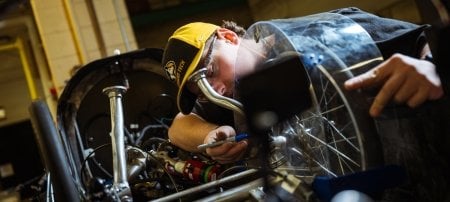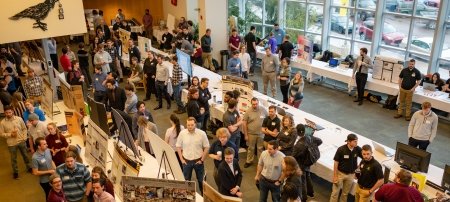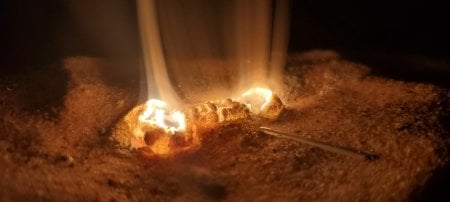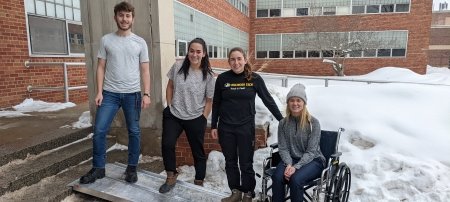Design Expo 2015 Success: Winners, Senior Design and Enterprise Projects

Student innovators filled the ballroom of the Memorial Union Building on Thursday, April 16, and the space buzzed with conversation and the occasional metallic clank. More than 600 Michigan Technological University students participated, through Senior Design teams and the Enterprise Program.
The International Business Ventures took first place in the Enterprise program and the “Aluminum Corrosion Study—Automotive Electrical Systems” team placed first for Senior Design. In Enterprise, Consumer Product Manufacturing and Velovations took second and third. In Senior Design, “Front End Protection for Data Acquisition” team and “Design & Development of an Automated Stacker for Highway Products of Nucor Steel Corporation” placed second and third. Three teams were awarded Honorable Mentions.
Design Expo is a showcase, an opportunity for students to display and discuss their projects. Many are interdisciplinary and cover a range of topics from automotive innovation to app software to geologic analysis. This year, several projects incorporated 3-D printing in innovative ways.
3-D Printing Designs
The plastic model in Kathleen Ikeda’s hand looks like a chubby bendy straw that had an unfortunate adventure in the oven. But it’s actually a 3-D printed version of an aneurysm bulge in an artery. The small pinched section in the middle is a device designed by a biomedical engineering student team.
“We’re evaluating this device that can bypass the clot,” says Kyle Johnston, who is one of the Senior Design team members. He explains the plastic model is the physical version of the design the team developed using virtual processing software. Basically, they were able to create a highly accurate and fine-tuned device using a computer program — and even tested their work virtually, saving tens of thousands of dollars in equipment. The design was made for Materialise, which specializes in 3-D printing software and services.
“In way, we’re like contractors,” Ikeda says. “We’re showing the company how their software could be integrated into a new field — it demonstrates the versatility of their services.”
In general, 3-D printing is highly versatile. And now metal 3-D printing is showing promise.
“I joined this Enterprise project because it’s pretty much on the cutting edge,” says Martin Schaub, a mechanical engineering student and team member of the “Welding Parameter Refinement for 3-D Printing” design project.
Schaub and his teammates used a welder to stack layers of aluminum. The process can get hot — though it’s gone in a flash — leaving behind beads of aluminum. The students were challenged to deal with “pooling,” where the beads deform as the metal stacks up.
Matching wits with challenges is the bread and butter of Design Expo projects. To effectively solve the problems, some students have to learn to work on interdisciplinary teams.
Interdisciplinary Team Work
One such team has worked on an automated parts counting system for MacLean-Fogg. The team’s machine uses fins, bars and bays to sift and sort metal parts. The bolts, pins, screws and other fastener parts fall down the chute, bounce off the fins and bars, which reorients them, and then they are separated out into bays equipped with sensors.
The project required both electrical and mechanical engineering.
“We learn a lot from each other,” Robert Dudek says, who is one of the mechanical engineering students. “Plus, we had access to more professors and resources by working together.”
Andrew Harmon, an electrical engineering senior, admits, “I learned more about welding than I thought possible.”
Other design teams are also interdisciplinary, especially many in the Enterprise program. For example, the Green Campus Enterprise has an open call out for all majors, and the mine water geothermal project under the Alternative Energy Enterprise worked with students in more than five disciplines.
The team work prepares students for the ultimate test: the real world.
Hovercrafts, Lawn Sweepers and the Real World
For the one-man hovercraft team, creating a safe and reliable machine for the senior design project was crucial for testing. The hovercraft was initially human-powered, which team member Matthew Benzick says was unique.
“But you had to have the strength of Lance Armstrong to run it,” he says. The team is now figuring out how to create a better propeller; they plan to use 3-D printing to make the piece this summer.
Andrew Halla works on a different machine, but is also working on refining a crucial component. He and his team engineered better fingers — not for a hand, but for a lawn sweeper.
Living on the Keweenaw Peninsula means long winters, and come spring, campus lawns are pretty grungy. The lawn sweepers keep the grounds tidy, but the plastic fingers they use to brush away debris tend to break. So, Halla and his team redesigned them.
“Once we implement this on the machine, it will make the task easier for workers,” Halla says. “And it would be rewarding to see our project out on the lawns every spring on campus.”
Whether their projects go out to the Michigan Tech lawns, local clinics or to a company, the Design Expo showcases students’ hands-on, real world skills.
Michigan Technological University is an R1 public research university founded in 1885 in Houghton, and is home to nearly 7,500 students from more than 60 countries around the world. Consistently ranked among the best universities in the country for return on investment, Michigan's flagship technological university offers more than 120 undergraduate and graduate degree programs in science and technology, engineering, computing, forestry, business, health professions, humanities, mathematics, social sciences, and the arts. The rural campus is situated just miles from Lake Superior in Michigan's Upper Peninsula, offering year-round opportunities for outdoor adventure.




Comments